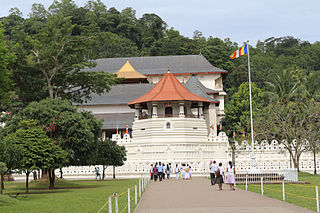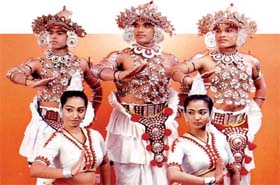
Kandy is a major city in Sri Lanka located in the Central Province. It was the last capital of the ancient kings' era of Sri Lanka. The city is situated in the midst of hills in the Kandy plateau, which crosses an area of tropical plantations, mainly tea. Kandy is both an administrative and religious city and the capital of the Central Province. Kandy is the home of the Temple of the Tooth Relic, one of the most sacred places of worship in the Buddhist world. It was declared a World Heritage Site by UNESCO in 1988. Historically the local Buddhist rulers resisted Portuguese, Dutch, and British colonial expansion and occupation.

Minnette de Silva was an internationally recognised architect, considered the pioneer of the modern architectural style in Sri Lanka. De Silva was a fellow of the Sri Lanka Institute of Architects (SLIA),

The culture of Sri Lanka mixes modern elements with traditional aspects and is known for its regional diversity. Sri Lankan culture has long been influenced by the heritage of Theravada Buddhism passed on from India, and the religion's legacy is particularly strong in Sri Lanka's southern and central regions. South Indian cultural influences are especially pronounced in the northernmost reaches of the country. The history of colonial occupation has also left a mark on Sri Lanka's identity, with Portuguese, Dutch, and British elements having intermingled with various traditional facets of Sri Lankan culture. Additionally, Indonesian culture has also influenced certain aspects of Sri Lankan culture. Culturally, Sri Lanka possesses strong links to both India and Southeast Asia. For over 2,500 years, India and Sri Lanka have nurtured a legacy of historical, cultural, religious, spiritual, and linguistic connections.

King Rajasinghe II, also known as Rajasingha II, was a Sinhalese King, reigned 1629 – 6 December 1687; seventh king of the Kingdom of Kandy in Sri Lanka. Rajasingha requested aid from the newly formed Dutch East India Company to help expel the Portuguese from the island, which they successfully did in 1656. By this time however it had become clear to the Kandyans that the Dutch not only intended to expel the Portuguese but to replace them as the major colonial power on the island. This transfer of power is also believed to be where the Sinhala idiom / figure of speech “ඉඟුරු දී මිරිස් ගත්තා වාගේ” Inguru di miris gaththa wagay was originated - in reference that the Dutch Rule was much more of a menace to the king and cruel to the people in the island than the Portuguese. From 1645 onwards Rajasingha was engaged in sporadic warfare with his erstwhile allies.
The caste systems in Sri Lanka are social stratification systems found among the ethnic groups of the island since ancient times. The models are similar to those found in Continental India, but are less extensive and important for various reasons. Modern times Sri Lanka is often considered to be a casteless society in south asia.

Kandyan dance encompasses various dance forms popular and native to the area called Kandy of the Central Hills region known as Udarata in Sri Lanka, which have today spread to other parts of the country. It is an example of Sinhalese culture in Sri Lanka.

The Kandy Esala Perahera also known as The Festival of the Tooth is a festival held in July and August in Kandy, Sri Lanka. This historical procession is held annually to pay homage to the Sacred Tooth Relic of Buddha housed at the Sri Dalada Maligawa in Kandy. A unique symbol of Sri Lanka, the procession consists of traditional local dances such as fire dances and performances in whip-dance garments. The festival ends with the traditional Diya-kepeema ritual, a water cutting ceremony which is held at the Mahaweli River at Getambe, Kandy.

There are several styles of classical and folk dance in Sri Lanka.

The Trinity College Chapel in Kandy, Sri Lanka is one of the more distinctive church buildings in Sri Lanka. It is situated below the Principal's bungalow at Trinity College, Kandy. The chapel is one of the first and finest examples of the application of indigenous architecture in the design of an Anglican church in the country. The building is modelled on traditional Buddhist architecture, reminiscent of those found in Polonnaruwa, an ancient capital of Sri Lanka, in that it is an open building with a lofty hipped roof supported by numerous carved stone pillars.

In the Kingdom of Kandy in Sri Lanka, the Kings maintained a harem that consisted of a chief queen and one or two secondary queens. In addition to the queens, the harem also included concubines, who were divided into three categories based on their rank. The highest-ranking category was Randoli, which consisted of consorts of royal blood who held the position of chief queen. The second category, Rididoli, consisted of consorts from either noble families of royal lineage or sisters of Randoli. The lowest ranking category was Yakadadoli, who were from the Radala (Elite) castes.

British Ceylon, officially British Settlements and Territories in the Island of Ceylon with its Dependencies from 1802 to 1833, then the Island of Ceylon and its Territories and Dependencies from 1833 to 1931 and finally the Island of Ceylon and its Dependencies from 1931 to 1948, was the British Crown colony of present-day Sri Lanka between 1796 and 4 February 1948. Initially, the area it covered did not include the Kingdom of Kandy, which was a protectorate, but from 1817 to 1948 the British possessions included the whole island of Ceylon, now the nation of Sri Lanka.

The Kingdom of Kandy was a monarchy on the island of Sri Lanka, located in the central and eastern portion of the island. It was founded in the late 15th century and endured until the early 19th century.

The Royal Palace of Kandy, situated in Kandy, Sri Lanka, is a historical complex that served as the official residence for the monarchs of the Kingdom of Kandy until the advent of British colonial rule in 1815. It is noteworthy for its adherence to traditional Kandyan architectural styles, the buildings within the palace complex contains well-preserved examples of intricate woodwork, finely crafted stone carvings, and ornate wall murals. This complex encompasses a range of structures, including the Audience Hall, the Queen's Palace, the King's Palace, and the Temple of the Tooth Relic, a venerated Buddhist temple with global significance. Both the palace complex and the Temple of the Tooth are recognised as UNESCO World Heritage Sites.

The Temple of the Sacred Tooth Relic, or Sri Dalada Maligawa, is a Buddhist temple in Kandy, Sri Lanka. It is located in the royal palace complex of the former Kingdom of Kandy, which houses the relic of the tooth of the Buddha. Since ancient times, the relic has played an important role in local politics because it is believed that whoever holds the relic holds the governance of the country. The relic was historically held by Sinhalese kings. The temple of the tooth is a World Heritage Site mainly due to the temple and the relic.

In the history of Sri Lanka, the Kandyan Convention was a treaty signed on 2 March 1815 between the British governor of Ceylon, Sir Robert Brownrigg, and the chiefs of the Kandyan Kingdom, British Ceylon, for the deposition of King Sri Vikrama Rajasinha and ceding of the kingdom's territory to the British Crown. It was signed in the Magul Maduwa of the Royal Palace of Kandy.

The National Museum of Kandy in Kandy, Sri Lanka is located next to the Temple of the Tooth in part of the former Royal Palace of Kandy. The primary exhibits are housed in the Palle Vahala building, which was the former home of the King's harem. A secondary exhibition is located in the main palace building. The museum is maintained by the Department of National Museums.
Deiannewela or Deiyannewela is a Village Officer Domain of Gangawata Korale Divisional Secretariat in Kandy District, Central Province, Sri Lanka. It is the location of a railway station and the National Hospital.

Sinhalese–Portuguese conflicts refers to the series of armed engagements that took place from 1518 to 1658 in Sri Lanka between the native Sinhalese kingdoms and the Portuguese Empire. It spanned from the Transitional to the Kandyan periods of Sri Lankan history. A combination of political and military moves gained the Portuguese control over most of the island, but their invasion of the final independent kingdom was a disaster, leading to a stalemate in the wider war and a truce from 1621. In 1638 the war restarted when the Dutch East India Company intervened in the conflict, initially as an ally of the Sinhalese against the Portuguese, but later as an enemy of both sides. The war concluded in 1658, with the Dutch in control of about half the island, the Kingdom of Kandy the other half, and the Portuguese expelled.

Pekada, or pekadaya, are the decorative wooden pillar heads/brackets at the top of a stone or wooden column, known as kapa, supporting a beam or dandu. It is a unique feature of Kandyan architecture.
















